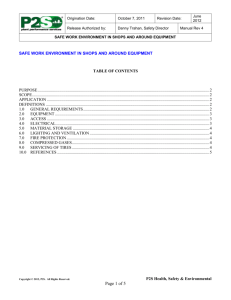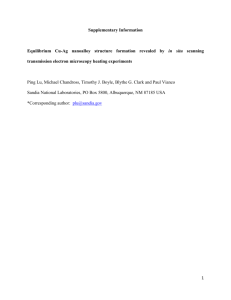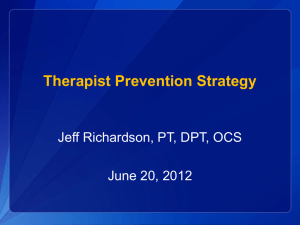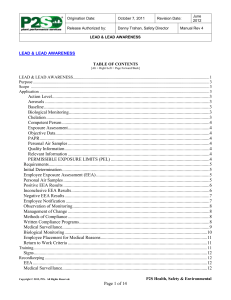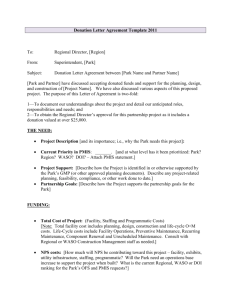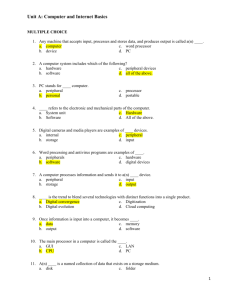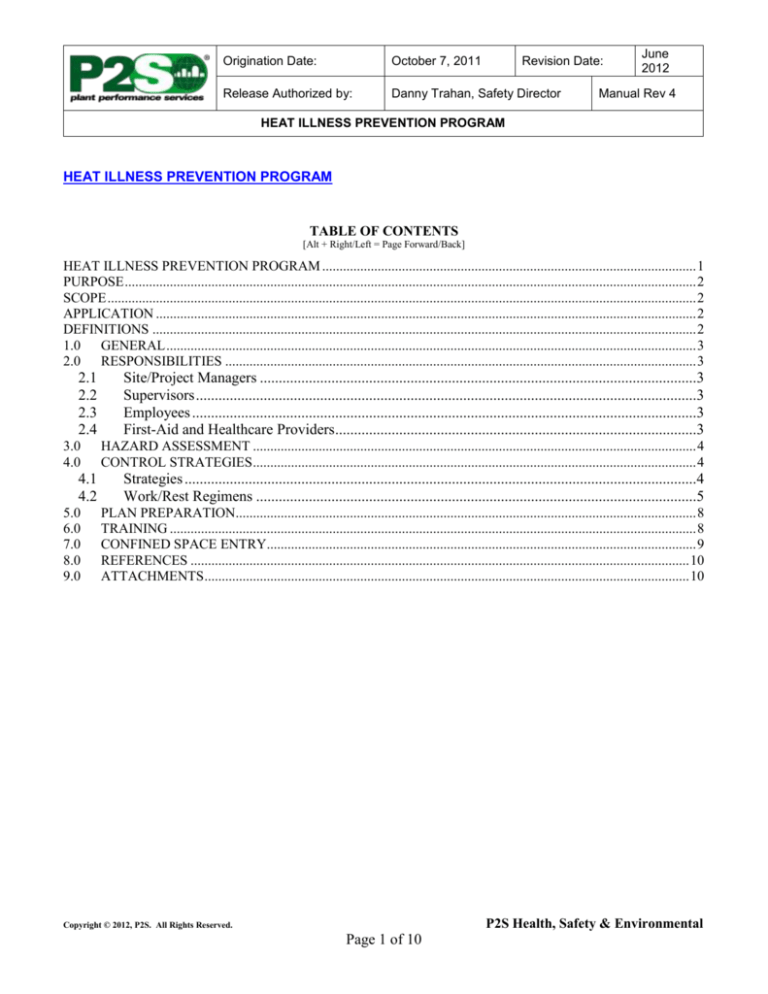
Origination Date:
October 7, 2011
Revision Date:
Release Authorized by:
Danny Trahan, Safety Director
June
2012
Manual Rev 4
HEAT ILLNESS PREVENTION PROGRAM
HEAT ILLNESS PREVENTION PROGRAM
TABLE OF CONTENTS
[Alt + Right/Left = Page Forward/Back]
HEAT ILLNESS PREVENTION PROGRAM ............................................................................................................ 1
PURPOSE ..................................................................................................................................................................... 2
SCOPE .......................................................................................................................................................................... 2
APPLICATION ............................................................................................................................................................ 2
DEFINITIONS ............................................................................................................................................................. 2
1.0 GENERAL ......................................................................................................................................................... 3
2.0 RESPONSIBILITIES ........................................................................................................................................ 3
2.1
2.2
2.3
2.4
3.0
4.0
4.1
4.2
5.0
6.0
7.0
8.0
9.0
Site/Project Managers ....................................................................................................................3
Supervisors .....................................................................................................................................3
Employees ......................................................................................................................................3
First-Aid and Healthcare Providers................................................................................................3
HAZARD ASSESSMENT ................................................................................................................................ 4
CONTROL STRATEGIES ................................................................................................................................ 4
Strategies ........................................................................................................................................4
Work/Rest Regimens .....................................................................................................................5
PLAN PREPARATION..................................................................................................................................... 8
TRAINING ........................................................................................................................................................ 8
CONFINED SPACE ENTRY............................................................................................................................ 9
REFERENCES ................................................................................................................................................ 10
ATTACHMENTS ............................................................................................................................................ 10
P2S Health, Safety & Environmental
Copyright © 2012, P2S. All Rights Reserved.
Page 1 of 10
Origination Date:
October 7, 2011
Revision Date:
Release Authorized by:
Danny Trahan, Safety Director
June
2012
Manual Rev 4
HEAT ILLNESS PREVENTION PROGRAM
PURPOSE
This practice defines the requirements for the management of work in severe heat in order to protect employees
from the effects of heat stress.
SCOPE
This practice includes the following major sections:
General Requirements
Responsibilities
Hazard Assessment
Control Strategies
Plan Preparation
Training
Confined Space Entry
APPLICATION
This practice applies to work activities and employees under the control of P2S and its contractors.
DEFINITIONS
Acclimatization – Is the gradual adapting of the human body to cope with higher heat exposure. Acclimatization
occurs over a period of approximately 2 weeks but may be lost within 1 week of removal of the heat exposure.
There can be a noticeable decrease in acclimatization over a weekend off work.
Heat Stress – The general term that describes a variety of symptoms produced when the human body is exposed to
a combination of heat and work that interferes with the body’s ability to dissipate the heat energy. Heat stress is a
function of total heat load and includes the level of activity and environmental conditions.
Heat Rash – Often referred to as “prickly heat”. This skin rash is caused by excess sweating or the skin being wet
with sweat. The rash usually disappears with acclimatization or removal from heat.
Heat Stroke – This is a serious, life-threatening medical condition. The person has a temperature in excess of 104
degrees F (40 degrees C), sweating often stops, the skin is hot, pulse is rapid, there may be dizziness, weakness,
headache, nausea, and visual disturbances. The person may be aggressive and irrational and convulsing. Urgent
medical attention must be sought.
Heat Exhaustion – Heat exhaustion may take many days to develop and be characterized by a progressive decline
in work performance; lack of appetite; headache; cold, clammy, pale skin; rapid, weak pulse; nausea; and vomiting.
The person may collapse.
Heat Cramp – There are painful muscle cramps of the limbs and/or abdomen, muscle twitching, tingling, or pins
and needles in the hands and feet. The person may experience tiredness and nausea. The symptoms may be due to
a salt imbalance.
P2S Health, Safety & Environmental
Copyright © 2012, P2S. All Rights Reserved.
Page 2 of 10
Origination Date:
October 7, 2011
Revision Date:
Release Authorized by:
Danny Trahan, Safety Director
June
2012
Manual Rev 4
HEAT ILLNESS PREVENTION PROGRAM
1.0
GENERAL
Heat stress generally describes the effect of heat, from any source, on the organs of the body and the person as a
whole. The stresses of heat on the body manifest themselves in 5 common ailments:
Heat exhaustion
Heat cramps
Heat stroke
Heat syncope
Heat rash.
When heat levels become higher than 95 degrees F (35 degrees C) for whatever reason (natural weather conditions
or mechanical heat sources), a plan must be developed and implemented such that employees do not develop heatrelated illnesses. This plan can be a stand-alone document or a section in the job safety analysis (JSA).
Different parts of the country and world have different environmental conditions that must be considered when
developing the plan.
2.0
RESPONSIBILITIES
2.1
Site/Project Managers
Site/Project Managers are responsible for compliance with this practice. Managers, both P2S and contractor, share
concurrent responsibility with HSE and occupational healthcare providers to develop the plan to avoid heat-related
illnesses.
2.2
Supervisors
When and where there is a potential for heat stress to occur, supervisors are responsible for communicating the
plan/process to employees. Supervisors will implement the plan to avoid heat-related illnesses; this will include,
but not be limited to, conducting an assessment of tasks in order to identify possible work practices or environments
that have the potential to cause heat stress.
Supervisor, and team leaders, must continually monitor their employees and instruct them to comply with plan
elements.
2.3
Employees
Employees are expected to respond to work instructions. There should be no unilateral cessation of work.
2.4
First-Aid and Healthcare Providers
Healthcare professionals will monitor employees and report to the HSE Representative all cases that involve, or are
suspected of involving, occupational heat-related illnesses. An emergency plan for handling heat-related illness
must be developed by healthcare professionals and implemented as required.
P2S Health, Safety & Environmental
Copyright © 2012, P2S. All Rights Reserved.
Page 3 of 10
Origination Date:
October 7, 2011
Revision Date:
Release Authorized by:
Danny Trahan, Safety Director
June
2012
Manual Rev 4
HEAT ILLNESS PREVENTION PROGRAM
3.0
HAZARD ASSESSMENT
An assessment of tasks will be undertaken in order to identify possible work practices or environments that have
the potential to cause heat stress. Potential heat stress situations include, but are not limited to:
4.0
Working close to furnaces, ovens, etc.
Working outside in hot climate conditions.
Heavy physical work when wearing occlusive protective clothing such as acid suits
and disposable overalls.
Working in confined spaces where there may be reduced air movement, high humidity
increased workload, and higher temperatures.
Working in close proximity of uninsulated metal wall or roof cladding.
CONTROL STRATEGIES
4.1
Strategies
When working in heat, employees must take appropriate precautions for themselves and those working around or
adjacent to them. Strategies to control or minimize the effects of working in heat include the following:
Obtain long-range weather forecasts and regularly update the forecasts to provide the
maximum possible warning period of inclement weather conditions.
Consider earlier starting and finishing times to avoid the hottest part of the day.
Program heavy, physical work for the early or cooler times of the day.
Identify hot spots or areas of work to be avoided during extreme heat.
Re-program work in hot spots to another time of the day or to another day.
Hold toolbox meetings, training programs, and HSE meetings in cool areas or
air-conditioned areas at the hottest part of the day.
Alternate work crews to provide rest periods.
Provide regular rest periods at intervals appropriate to the work conditions in cool,
shaded, or air-conditioned environments.
Provide ample cool drinking water at the work location.
Consider drinks with electrolyte replacement available at the work location.
Note: It must be stressed to employees working in heat that excessive use of such
drinks may be detrimental to their health.
Consider engineering factors to prevent heat stress, such as increasing air movement,
shielding sources of radiant heat, and insulating hot areas.
Mechanize the task.
Review the potential impacts of protective clothing.
Provide regular rest periods and strictly adhere to schedule appropriate to the work
conditions and in cool/shaded or air-conditioned environments.
Change working hours to avoid peak heat-load periods.
P2S Health, Safety & Environmental
Copyright © 2012, P2S. All Rights Reserved.
Page 4 of 10
Origination Date:
October 7, 2011
Revision Date:
Release Authorized by:
Danny Trahan, Safety Director
June
2012
Manual Rev 4
HEAT ILLNESS PREVENTION PROGRAM
Provide suitable mineral and electrolyte replacements at the first-aid facility.
However, it must be stressed to employees working in heat that excessive use of such
drinks may be detrimental to their health.
Note: Salt tablets are not recommended.
Provide additional personal protective equipment (PPE). Items of PPE that may be of
benefit are:
A hat to protect face, neck, and ears. Where practicable, hard hats should be
fitted with broad brims and neck flaps.
Sunscreens should be selected in accordance with the skin type and working
conditions of the user. In general, sunscreens should be 30+ SPF broad spectrum
water-resistant types.
Eye protection should be provided through the use of glasses that provide
adequate UV and impact protection.
Note: PPE will be used as a control measure only where other measures are
impracticable or inadequate.
Reduce heat source (such as install shaded areas, cooling fans, and insulation).
When working in heat, employees must take appropriate precautions for themselves and those working around or
adjacent to them.
4.2
Work/Rest Regimens
Heat stress is dependent on the activity level and the environment around the employee. Specialized help to assess
the risk must be consulted when radiant heat is a major contributor. When no radiant heat is present, the following
can be used as guidance for the maximum exposure time to high temperature.
Estimate the activity level with the aid of Table 1. Read the maximum exposure temperature (wet temperature) in
Table 2 — this is the maximum exposure temperature at 100 percent humidity. Usually the humidity is lower,
more heat can be removed by sweating, and a higher dry temperature is allowed. This dry temperature is the
temperature normally referenced and can be derived from the wet temperature and the relative humidity with the
aid of Chart 3.
P2S Health, Safety & Environmental
Copyright © 2012, P2S. All Rights Reserved.
Page 5 of 10
Origination Date:
October 7, 2011
Revision Date:
Release Authorized by:
Danny Trahan, Safety Director
June
2012
Manual Rev 4
HEAT ILLNESS PREVENTION PROGRAM
Table 1 – Activity Level
#
0
1
Class
description
Resting
Low activity
rate
2
Moderate
activity rate
3
High activity
rate
4
Very high
activity rate
Example
Resting
Sitting at ease: light manual work (writing, typing,
drawing, sewing, book-keeping); hand and arm work
(small bench tools, inspection, assembly or sorting of light
materials; arm and leg work (driving vehicle in normal
conditions, operating foot switch or pedal).
Standing: drill (small parts); milling machine (small
parts); coil winding; small armature winding; machining
with low power tools; casual walking (speed up to 2.2
mph [3.5 km/h]
Sustained hand and arm work (hammering in nails,
filling); arm and leg work (off-road operation of lorries,
tractors ,or field execution equipment); arm and trunk
work (work with pneumatic hammer, tractor assembly,
plastering, intermittent handling of moderately heavy
material, weeding, hoeing, picking fruit or vegetables);
pushing or pulling light weight carts or wheelbarrows;
walking at a speed of 2.2 to 3.4 mph (3.5 to 5.5 km/h)
forging
Intense arm and trunk work; carrying heavy material;
shoveling; sledge hammer work; sawing, planning, or
chiseling hard wood; hand mowing; digging; walking at a
speed of 3.4 to 4.3 mph (5.5 to 7 km/h)
Pushing or pulling heavily loaded handcarts or
wheelbarrows; chipping castings; concrete block laying
Very intense activity at fast to maximum pace; working
with an axe; intense shoveling or digging; climbing stairs,
running, walking at a speed greater than 4.3 mph (7 km/h)
Table 2 – Maximum Exposure Temperatures (wet temperature at 100% humidity)
#
Class
description
0
Resting
Maximum exposure temperature (F / C, wet at 100%
humidity)
Person not acclimatized
Person acclimatized to heat
to heat
91 F/33 C
90 F/32 C
P2S Health, Safety & Environmental
Copyright © 2012, P2S. All Rights Reserved.
Page 6 of 10
Origination Date:
October 7, 2011
Revision Date:
Release Authorized by:
Danny Trahan, Safety Director
June
2012
Manual Rev 4
HEAT ILLNESS PREVENTION PROGRAM
1
2
3
4
Low activity
rate
Moderate
activity rate
High activity
rate
Very high
activity rate
86 F/30 C
84 F/29 C
82 F/28 C
79 F/26 C
No sensible
air movement
Sensible air
movement
77 F/25 C
79 F/26 C
73 F/23 C
77 F/25 C
No
sensible air
movement
72 F/22
C
Sensible
air
movement
73 F/23
C
64 F/18
C
68 F/20
C
Chart 3 – Conversion Wet Temperature to Dry Temperature
P2S Health, Safety & Environmental
Copyright © 2012, P2S. All Rights Reserved.
Page 7 of 10
Origination Date:
October 7, 2011
Revision Date:
Release Authorized by:
Danny Trahan, Safety Director
June
2012
Manual Rev 4
HEAT ILLNESS PREVENTION PROGRAM
Example: What is the corresponding dry temperature for 30 ºC (wet) when humidity is at 60 percent?
Look up the top curved line with the indication 100 percent.
Find 30 ºC.
Follow the straight line towards the right-hand bottom corner till curved line indicating 60
percent is met.
Follow the vertical line to the bottom of the chart.
Read the temperature (= 37 ºC).
Note:
5.0
ºC = (ºF x 5/9) –32
ºF = (ºC x 9/5) + 32
PLAN PREPARATION
The plan should contain the following:
Conditions in the workplace that are based upon environmental factors including
ambient temperature, relative humidity, air velocity, and thermal radiation.
Note: Document results of measurements on Form 000.653.F0283 (Heat Stress/WBGT
Monitoring Log) or similar.
On the basis of temperatures measured, a ratio of work time versus rest periods, with
work periods decreasing while rest periods increase as temperature/humidity rises.
A medical monitoring regimen for those employees exposed to heat stress, especially
those who are likely to be susceptible to heat stress (the obese, unacclimatized with
cardio circulatory diseases, and employees who may be taking medications or using
alcohol heavily).
A process for handling heat stroke and severe heat exhaustion (heat-related medical
emergencies)
Training to include dietary needs, water consumption, and avoidance of alcohol.
An example plan is provided in Attachment 01.
6.0
TRAINING
Supervisors and their employees who are potentially exposed to heat stress-inducing conditions must receive
training to include the following topics:
Physiological aspects of heat stress
Causes of heat related illness:
High air temperature/humidity
Lack of air movement
Radiant heat
Lack of fluids
Lack of acclimatization
High rate of physical activity
P2S Health, Safety & Environmental
Copyright © 2012, P2S. All Rights Reserved.
Page 8 of 10
Origination Date:
October 7, 2011
Revision Date:
Release Authorized by:
Danny Trahan, Safety Director
June
2012
Manual Rev 4
HEAT ILLNESS PREVENTION PROGRAM
Symptoms of heat stress
Heat stress – tiredness, irritability, cramps, cool clammy skin, profuse sweating
Heat stroke – headache, nausea/vomiting, dizziness, irritability, confusion, dry
skin, flushed, increased body temperature
Influence of radiated, convected, and metabolic heat; air movement; clothing; and
work rates
Importance of fluid intake
Detrimental effects of alcohol
Work/rest regimens
Control strategies
Measures for the prevention of heat-related illness are as follows:
Drink approximately 2-3 gallons (8-11 liters) of water per day.
Schedule physical work during cooler periods of the day.
Avoid alcohol and excessive sugar drinks.
Regular rest breaks.
Wear appropriate clothing.
Protect from direct sun.
Acclimatization.
Supervisors must receive training on identifying heat-related illness as follow:
Remove the affected employee to a cool area as soon as possible.
Seek medical or paramedic assistance.
Attempt to cool the body by means of water.
Where possible give the affected employee water to drink.
First-aid providers must receive specific training in the recognition, treatment, and management of heat stress
victims.
Training will be conducted as follows:
7.0
During site orientation
Before commencement of the job/task that poses the risk
Before the risk period (such as start of summer months)
CONFINED SPACE ENTRY
Where a potential heat stress situation is identified in a confined space workers entering the space will receive
specific instructions regarding the precautions necessary
The heat-related hazard will be recorded on the confined space entry permit.
The standby person/attendant will be trained in the recognition and initial, first-aid
treatment of heat-related illnesses.
P2S Health, Safety & Environmental
Copyright © 2012, P2S. All Rights Reserved.
Page 9 of 10
Origination Date:
October 7, 2011
Revision Date:
Release Authorized by:
Danny Trahan, Safety Director
June
2012
Manual Rev 4
HEAT ILLNESS PREVENTION PROGRAM
8.0
9.0
REFERENCES
Document ID
Document Title
000.653.F0283
Heat Stress/WBGT Monitoring Log
ATTACHMENTS
Attachment No.
Attachment Title
Attachment 01
Sample Heat Stress Plan
P2S Health, Safety & Environmental
Copyright © 2012, P2S. All Rights Reserved.
Page 10 of 10

